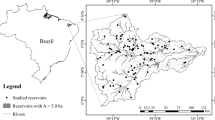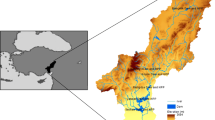Abstract
During recent years, the international attention paid to rational use and saving of water has increased, partly because of frequent water shortages occurring also in countries not usually involved in these problems, and partly as a consequence of rising conflicts on water allocation. Hence it is important to find new surface-water volumes satisfying agricultural water demand, as well as new ways and areas to store them. The simulation model presented by the paper enables evaluation, in a phase of design feasibility analysis, of whether a flood detention pond can be adapted to act as water storage during irrigation periods in order to reduce agricultural water shortages; it simulates detention pond response to floods and droughts under different hydraulic conditions and reservoir management rules. The first policy goal of the model is to maintain the stored volume within the maximum admissible for flood safety. The second goal is to maintain at the same time a minimum flow in the river and to satisfy irrigation water demand. The model, implemented in a purpose-made simulation software, was applied to an Italian river in the Emilia Romagna region: the results demonstrate that the use of a flood detention pond as an irrigation reservoir is not only possible, if it complies with the operating rules that emerge from this study, but also it brings tangible benefits in reducing agricultural water deficit.
Similar content being viewed by others
References
Akan AO, Antoun EN (1994) Runoff detention for flood volume or erosion control. J Irrig Drain Eng 120(1):168–178
Akbari M, Afshar A, Sadrabadi MR (2009) Fuzzy rule based models modification by new data: application to flood flow forecasting. J Water Resour Manage 23:2491–2504
Bonaccorso B (2003) An analytical formulation of return period of drought severity. Stoch Environ Res Risk Assess 17:157–174
Chang TJ, Kleopa XA, Teoh CB (1995) Use of flood-control reservoirs for drought management. J Irrig Drain Eng 121(1):34–42
De Roo Ad PJ, Gouweleeuw B, Thielen J et al. (2003) Development of a European flood forecasting system. Intl J River Basin Manage 1(1):49–59
Duren FK, Beard LR (1972) Optimizing flood control allocation for a multipurpose reservoir. Water Resour Bull 8(4):735–744
El-Shafie A, Abdin AE, Noureldin A, Taha MR (2009) Dam utilizing radial basis neural network and upstream monitoring stations measurements. J Water Resour Manage 23:2289–2315
Eschenbach EA, Magee T et al. (2001) Goal programming decision support system for multiobjective operation of reservoir systems. J Water Resour Plan Manage 127(2):108–120
Gandolfi C, Guariso G, Togni D (1995) Optimal flow allocation in multireservoir network: the Zambesi system. Water Resour Manage 11(5):377–393
Ganoulis J (2003) Risk-based floodplain management: a case study from Greece. Intl J River Basin Manag 1(1):41–47
Gelli P (2005) Studio di fattibilità per la realizzazione di bacini irrigui nelle aree di cava nei comuni di Sassuolo e Casalgrande”, M.S. thesis in Civil Engineering, Bologna Univ., Bologna, Italy (in Italian)
Guariso G, Rinaldi S, Soncini-Sessa R (1986) The management of Lake Como: A multiobjective analysis. Water Resour Res 22:109–120
Karamouz M, Araghinejad S (2008) Drought mitigation through long-term operation of reservoirs: case study. J Irrig Drain Eng 124(4):471–478
Karamouz M, Zahraie B, Araghinejad S (2005) Decision support system for monthly operation of hydropower reservoir: a case study. J Comput Civ Eng 19(2):194–206
Khatibi R, Stokes R, Ogunyoye F, Solheim I, Jackson D (2003) Research issues on warning lead-time and synergy in flood mitigation measures. Intl J River Basin Manag 1(4):331–346
Kottegoda NT (1998) Statistics, Probability, and Reliability for Civil and Environmental Engineers. McGraw Hill, New York
Liu C (1972) Flood control storage allocations by linear programming. J Am Water Resour Assoc 8(5):976–986
Maione U, Brath A, Mignosa P (2000) La progettazione della difesa idraulica. Interventi di laminazione controllata delle piene fluviali, Bios (in Italian)
McEnroe BM (1992) Preliminary sizing of detention reservoirs to reduce peak discharges. J Hydraul Eng 118(11):1540–1549
Moisello U (1998) Idrologia Tecnica, La Goliardica Pavese (in Italian)
Nandalal KDW, Sakthivadivel R (2002) Planning and management of a complex water resource system: case of Smanalawewa and Udawalawe reservoirs in the Walawe river. Agric Water Manag 57(3):207–221
Rosso R (2002) Manuale di protezione idraulica del territorio, Cusl (in Italian)
Shiau JT (2003) Water release policy effect on the shortage characteristics for the Shihmen reservoir system during droughts. Water Resour Manage 17(6):463–480
Shiau JT, Lee HC (2005) Derivation of optimal hedging rules for a water supply reservoir through compromise programming. Water Resour Manage 19(2):111–132
Simonovic SP (1992) Reservoir system analysis: closing gap between theory and practise. J Water Resour Plan Manage 118(3):262–280
Tabellini P (1998) Analisi del rischio di piena nel bacino del fiume Secchia. M.S. thesis in Civil Engineering, Bologna Univ., Bologna, Italy (in Italian)
Tilmant A, Faouzi E, Vanclooster M (2002) Optimal operation of multipurpose reservoirs using flexible stochastic dynamic programming. J Appl Soft Comput 32(2):1–14
PTUA—“Piano di Tutela ed Uso delle Acque dell’Emilia Romagna” (“Law for water protection and use planning) (2005) Regione Emilia Romagna (in Italian)
Author information
Authors and Affiliations
Corresponding author
Rights and permissions
About this article
Cite this article
Camnasio, E., Becciu, G. Evaluation of the Feasibility of Irrigation Storage in a Flood Detention Pond in an Agricultural Catchment in Northern Italy. Water Resour Manage 25, 1489–1508 (2011). https://doi.org/10.1007/s11269-010-9756-z
Received:
Accepted:
Published:
Issue Date:
DOI: https://doi.org/10.1007/s11269-010-9756-z




